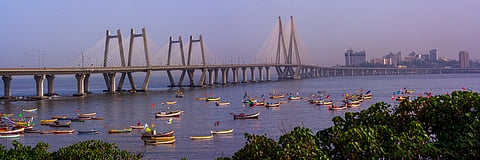
- Destinations
- Experiences
- Stay
- What's new
- Celebrating People
- Responsible Tourism
- CampaignsCampaigns
- SubscribeSubscribe
- Buy Now

As old as the oceans and seas they spend weeks sieving through for a bounty of fish, the Koli community of Mumbai, is the original inhabitants of the city. Their koliwadas or villages are entrenched along the city&rsquos coastline, from Mazgaon, Sion, Worli, Mahim, Khar, and Bandra, to Versova, and beyond. Tenacious about their traditions, the Koli are known variously as Son Koli, Macchimar Koli, Christian Koli, Vaiti Koli, and Mangela Koli.
Tough times
In recent years, the community has been feeling the brunt of not only a clogged and complicated supply chain but also commercial fishing involving large corporations, which use their licenses and territory demarcation for mechanized fishing. Then there is the added threat of building permissions granted without a thought about the destruction of the all-important mangroves. These natural bulwarks against floods, etc, are also home to commercially and ecologically important fish, crab, and prawn species, which have disappeared to a large extent. In conjunction with this, is the vanished practice of creek and coastal fishing, which was the mainstay of the Koli.
To counter this insurmountable issue, the Koli, too, have resorted to deep-sea trawler fishing using purse and gill nets, which catch a more significant load, including a large amount of non-edible marine life. This is opposed to artisanal fishing, which had been the traditional practice of the Koli. The ancient art of spear-fishing, trapping, netting, angling, and using a bow and arrow, by default, conserved nature, so it could continue to provide its bounty. There were different nets for each fish species, depending on their size.
To counter this insurmountable issue, the Koli, too, have resorted to deep-sea trawler fishing using purse and gill nets, which catch a more significant load, including a large amount of non-edible marine life. This is opposed to artisanal fishing, which had been the traditional practice of the Koli. The ancient art of spear-fishing, trapping, netting, angling, and using a bow and arrow, by default, conserved nature, so it could continue to provide its bounty. There were different nets for each fish species, depending on their size.
Rise And Shine
Despite the rising tidal wave of problems not of their making, the Koli continue to feed the fast-paced city of Mumbai, and make merry when the occasion arises.
At the Sassoon docks, the throngs await the seafood harvest that the Koli bring in. Famous not only for the seafood they sell but also for their scrumptious cuisine, the Koli have kept Mumbaiites enthralled for generations.
This season, if you cannot out-negotiate your local Koli fisherwoman on the price of her treasured fish or crab, head straight to one of the Koli food festivals that will soon take place across the city.
Dig in
From the most popular one, which takes place in January annually in Versova, to Agri-Koli Mahotsav of Nerul, and Vazira Koli Seafood Festival in Borivali, which takes place at the end of the year, the festivals are much-awaited. Mumbaiites demolish Koli food, with a lot of love and at an astonishing pace. Supported by the delightful stage performances by the Koli, and with our melamine dinner plates and spoons clutched tightly, we stand in long, best-performing queues, suffer cramped legs and pre-meal thirst, all in pursuit of the coconut-infused food.
We like to start off with the perfect bharela paplet, a stuffed pomfret wrapped in banana leaf parcels and fried, which gives it a delectable smoky flavour. There will always be ambat or sour curry, rice, and fried fish no matter which festival you decide to visit. A plateful replete with a bowl of nakwa soup or kanji, phatlun shipi, a shellfish curry, and tikhat moong dal, if you are eschewing non-vegetarian food, makes for a very happy Mumbaiite. Rounding off our bingeing, reluctantly, we enjoy the flavours of banana, sugar, and coconut as we bite into punya, and then undre modak.
